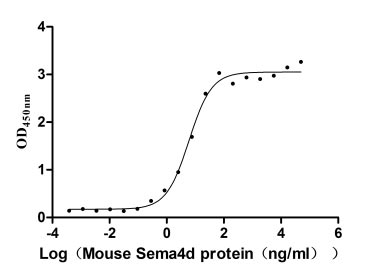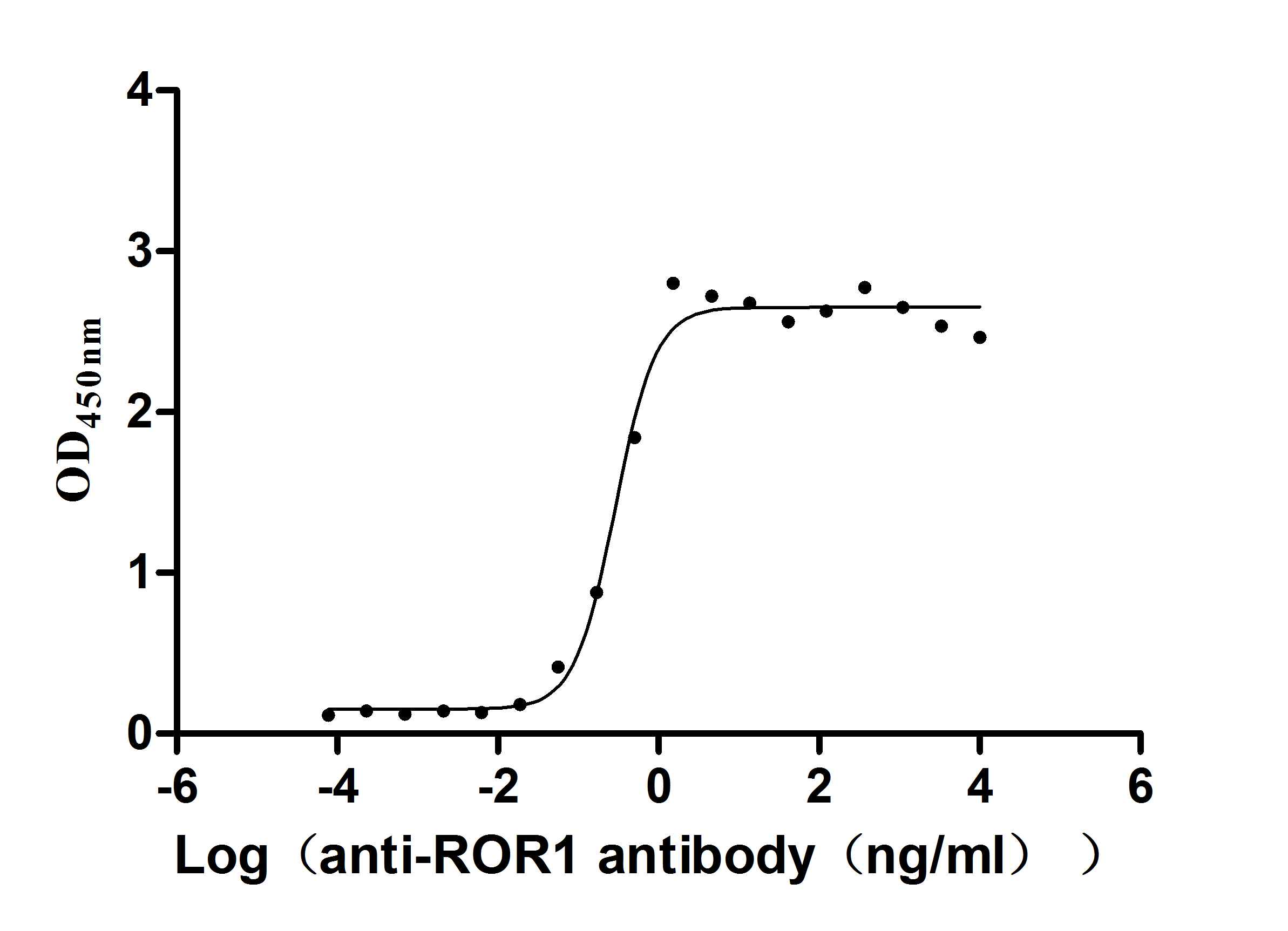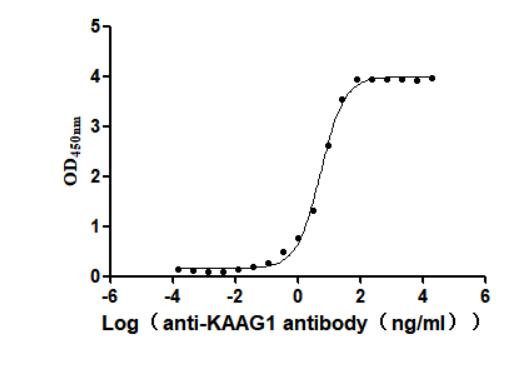Recombinant Mouse Dipeptidyl peptidase 4 (Dpp4), partial
-
货号:CSB-YP007139MO
-
规格:
-
来源:Yeast
-
其他:
-
货号:CSB-EP007139MO
-
规格:
-
来源:E.coli
-
其他:
-
货号:CSB-EP007139MO-B
-
规格:
-
来源:E.coli
-
共轭:Avi-tag Biotinylated
E. coli biotin ligase (BirA) is highly specific in covalently attaching biotin to the 15 amino acid AviTag peptide. This recombinant protein was biotinylated in vivo by AviTag-BirA technology, which method is BriA catalyzes amide linkage between the biotin and the specific lysine of the AviTag.
-
其他:
-
货号:CSB-BP007139MO
-
规格:
-
来源:Baculovirus
-
其他:
-
货号:CSB-MP007139MO
-
规格:
-
来源:Mammalian cell
-
其他:
产品详情
-
纯度:>85% (SDS-PAGE)
-
基因名:
-
Uniprot No.:
-
别名:Dpp4; Cd26; Dipeptidyl peptidase 4; Dipeptidyl peptidase IV; DPP IV; T-cell activation antigen CD26; Thymocyte-activating molecule; THAM; CD antigen CD26
-
种属:Mus musculus (Mouse)
-
蛋白长度:Partial
-
蛋白标签:Tag type will be determined during the manufacturing process.
The tag type will be determined during production process. If you have specified tag type, please tell us and we will develop the specified tag preferentially. -
产品提供形式:Lyophilized powder
Note: We will preferentially ship the format that we have in stock, however, if you have any special requirement for the format, please remark your requirement when placing the order, we will prepare according to your demand. -
复溶:We recommend that this vial be briefly centrifuged prior to opening to bring the contents to the bottom. Please reconstitute protein in deionized sterile water to a concentration of 0.1-1.0 mg/mL.We recommend to add 5-50% of glycerol (final concentration) and aliquot for long-term storage at -20℃/-80℃. Our default final concentration of glycerol is 50%. Customers could use it as reference.
-
储存条件:Store at -20°C/-80°C upon receipt, aliquoting is necessary for mutiple use. Avoid repeated freeze-thaw cycles.
-
保质期:The shelf life is related to many factors, storage state, buffer ingredients, storage temperature and the stability of the protein itself.
Generally, the shelf life of liquid form is 6 months at -20°C/-80°C. The shelf life of lyophilized form is 12 months at -20°C/-80°C. -
货期:Delivery time may differ from different purchasing way or location, please kindly consult your local distributors for specific delivery time.Note: All of our proteins are default shipped with normal blue ice packs, if you request to ship with dry ice, please communicate with us in advance and extra fees will be charged.
-
注意事项:Repeated freezing and thawing is not recommended. Store working aliquots at 4°C for up to one week.
-
Datasheet :Please contact us to get it.
相关产品
靶点详情
-
功能:Cell surface glycoprotein receptor involved in the costimulatory signal essential for T-cell receptor (TCR)-mediated T-cell activation. Acts as a positive regulator of T-cell coactivation, by binding at least ADA, CAV1, IGF2R, and PTPRC. Its binding to CAV1 and CARD11 induces T-cell proliferation and NF-kappa-B activation in a T-cell receptor/CD3-dependent manner. Its interaction with ADA also regulates lymphocyte-epithelial cell adhesion. In association with FAP is involved in the pericellular proteolysis of the extracellular matrix (ECM), the ...显示更多
-
基因功能参考文献:
- These data indicate that DPP-4 is modulated in a tissue specific manner and is dependent on physiological conditions such as hyperglycaemia and insulin resistance, suggesting a significant role in disorders such as diabetes. PMID: 29412816
- DPP4 activity when compared to healthy controls. Analysis of Dpp4-Liv-Tg mice revealed elevated systemic DPP4 activity and diminished active GLP-1 levels. PMID: 29031724
- hepatocyte DPP4 promotes visceral adipose tissue inflammation and insulin resistance in obesity, and targeting this pathway may have metabolic benefits that are distinct from those observed with oral DPP4 inhibitors PMID: 29562231
- DPP-4 inhibition with linagliptin slowed the progression of premature aging in klotho-/- mice. Provide a novel insight into the potential role of DPP-4 in the mechanism of premature aging. PMID: 29195509
- Chronic stress accelerates DPP4-mediated GLP-1 degradation and alters plasma adiponectin, accelerating vascular senescence and impairing ischemia-induced neovascularization. PMID: 28963101
- p53 limits ferroptosis of colorectal cancer cells by blocking DPP4 activity. PMID: 28813679
- DPP4 can regulate chronic stress-induced hematopoietic stemc cell activation and inflammatory cell production via an Adrbeta3/CXCL12-dependent mechanism that is mediated by the GLP-1/GLP-1R axis. PMID: 28710180
- DPPIV-knockout mice showed attenuation of scratching in psoriatic pruritus disease model. PMID: 28365081
- Actions of several substrate chemokines might be potentiated by downregulation of DPP-4, synergistically with upregulation of chemokines and their receptors in adipose tissues of obese mice. PMID: 28222464
- Inhibition of DPP-4 activity by linagliptin reverses Western diet-induced diastolic dysfunction, possibly by targeting TRAF3IP2 expression and its downstream inflammatory signaling. PMID: 28476142
- DPP4 is pro-fibrotic in Carbon tetrachloride-induced liver fibrosis. PMID: 27899813
- systemic DPP4 inhibition restores the impaired mononuclear cell homing in Eng+/- animals post-myocardial infarction, and enhances cardiac repair, which might be explained by restoring the balance between the inflammatory and regenerative macrophages present in the heart PMID: 29253907
- SGLT-2 inhibition with dapagliflozin reduces the activation of the Nlrp3/ASC inflammasome and attenuates the development of diabetic cardiomyopathy in mice with type 2 diabetes. Effects are augmentated of the by DPP4 inhibitor Saxagliptin. PMID: 28447181
- DPP-4 inhibitor teneligliptin inhibited atherogenesis in ApoE knockout mice, at least partially, through attenuation of the inflammatory phenotype of perivascular adipose tissue. PMID: 28347868
- Increased plasma DPP-4 activity may correlate with aneurysmal development. CD26 on monocytes plays a critical role in cell differentiation, possibly mediated by extracellular signal-regulated protein kinase 1/2-p21 axis signaling pathways and cytoskeletal proteins reassembly. PMID: 27887857
- High DPP4 expression is associated with cardiac ischemia and systolic dysfunction. PMID: 28771625
- these findings identify distinct roles for DPP4 in the endothelial cell versus the bone marrow compartment for selective incretin degradation and DPP4 inhibition-mediated glucoregulation. PMID: 27839908
- The trimeric form receptor-binding domain of MERS-CoV spike protein bound strongly to the receptor of MERS-CoV, dipeptidyl peptidase 4 (DPP4), and elicited robust RBD-specific neutralizing antibodies in mice. PMID: 27750111
- the data show that glucose-induced expression of Dpp4 in the liver is facilitated by demethylation of the Dpp4 gene early in life. This might contribute to early deteriorations in hepatic function, which in turn result in metabolic disease such as hepatosteatosis later in life. PMID: 27999105
- study reveals a cross talk between ATR signaling and DPP4 activation in the regulation of megalin and underscores the significance of targeting DPP4 in the prevention of obesity related kidney injury progression. PMID: 27213360
- Data (including data from studies in knockout mice) suggest that Cd26 (dipeptidyl peptidase IV) plays role in development and progression vs. resolution of ulcerative colitis; Cd26 deficiency in knockout mice is associated with heightened response to DSS (dextran sulfate sodium) in inducing colitis and is accompanied by increased expression of NF-kappaB p65 subunit and distinct changes in leukocyte trafficking/infiltra... PMID: 27125676
- DPP4 posttranslational modification of selected chemokines by truncation modifies their functional activities. PMID: 26943017
- DPP-4I, MK0626, but not native incretins has protective effects against AAA in Ang II-infused Apoe/ mice via suppression of inflammation, proteolysis, and fibrosis in the aortic wall PMID: 26549734
- Plasminogen may regulate DPP-4 activity and glucose metabolism. PMID: 27592166
- Data suggest that pharmacological stimulation of serotonin 5Ht1b receptor enhances up-regulation of plasma Glp1 (glucagon-like peptide 1) induced by Dpp4 (dipeptidylpeptidase 4) inhibition independently of feeding and also improves glucose tolerance. PMID: 26234524
- Young euglycemic Dpp4 KO mice showed a cardioprotective response after transverse aortic constriction or doxorubicin administration, with reduced fibrosis; however, cardiac mRNA analysis revealed increased expression of inflammation-related transcripts. PMID: 26672095
- Dipeptidyl peptidase-4 inhibition by gemigliptin exerts a preventative effect on the proliferation and migration of VSMCs via Nrf2. PMID: 26187356
- The present study reveals the activation of autophagy to mediate the anti-diabetic effect of GLP-1. PMID: 26802468
- These results indicate that DPP-4 inhibitors pleiotropically exert a direct renoprotective effect, and may serve as an additional therapeutic strategy to protect proximal tubular cells against proteinuria in patients with diabetic nephropathy. PMID: 26802469
- DPP-4 and integrin beta1 interactions regulate key endothelial cell signal transduction in both physiological and pathological conditions including endothelial mesenchymal transformation. PMID: 25830763
- sDPP-4 enhances inflammatory actions via TLR pathway, while DPP-4 inhibition with either an enzymatic or binding inhibitor has anti-inflammatory effects. PMID: 26773932
- DPP4i restores cardiac remodeling and apoptosis caused by the pathological decline in circulating GLP-1 in response to pressure overload. EPAC1 is essential for cardiomyocyte survival via the cAMP/Rap1 activation independently of PKA. PMID: 26721911
- Combination of DPP-4 inhibitor and PPARgamma agonist exerts protective effects on pancreatic beta-cells in diabetic db/db mice through the augmentation of IRS-2 expression PMID: 26116826
- DPP4 inhibiton appeared to suppress neointimal formation by inhibiting inflammation, independently of its effects on glucose or cholesterol metabolism in atherogenic LDL receptor KO mice. PMID: 25770025
- Report design, synthesis and activity of series of fused beta-homophenylalanine inhibitors of dipeptidyl peptidase-4. PMID: 25871012
- dipeptidyl peptidase 4 activity was impaired in animals with aggressive disease relative to cancer-free littermates. PMID: 25056937
- DPP4 inhibitors MK-0626 attenuates hepatic steatosis through enhancing AMPK activity, inhibiting hepatic lipogenic gene expression, enhancing triglyceride secretion from liver and increasing serum adiponectin levels. PMID: 25473177
- islet DPP-4 is species-specifically expressed in alpha-cell and beta-cell dominant patterns in several species and both patterns remained robust in enzyme activity during short-term metabolic challenge. PMID: 25268763
- Glycosylation of mouse DPP4 plays a role in inhibiting Middle East respiratory syndrome coronavirus infection. PMID: 25653445
- CD26 inhibition increased macrophage number around growing collaterals. PMID: 23391419
- These results indicate that DPPIV functions as a chemorepellent of human and mouse neutrophils PMID: 23677473
- Results provide preclinical evidence of CD26, in the hematopoietic stem cell transplantation (HSCT) recipient, as a major regulator of hematopoietic stem and progenitor cell (HSC/HPC) engraftment with minor effects on HSC/HPC homing. PMID: 22882234
- The nonenzymatic function of DPP4 on DC may play a role in potentiation of inflammation in obesity by interacting with adenosine deaminase. PMID: 22936179
- in both mice and rats, peripheral GLP-1 reduces food intake significantly less than Ex-4, even when protected from DPP-4 PMID: 23033273
- In the acute phase of colitis, colonic DPP IV activity is significantly decreased compared with healthy animals. PMID: 22125312
- DPPIV and NPY interact on lipid metabolism to promote adipose tissue depot. PMID: 22819773
- DPP-4 activity was inhibited by oral administration of linagliptin during healing. PMID: 22493041
- the ability of DPP-4 inhibition to suppress the progression to STZ-induced hyperglycaemia involves both alleviation of beta cell death and alpha cell proliferation PMID: 22072158
- dipeptidyl peptidase-4 inhibitor vildagliptin has an effect on glucose tolerance and beta-cell function and mass in insulin receptor substrate-2-knockout mice fed a high-fat diet PMID: 22315446
- CD26 expression was increased in dermal fibroblasts following skin wounding but was downregulated in tumour stroma PMID: 21765471
收起更多
-
亚细胞定位:[Dipeptidyl peptidase 4 soluble form]: Secreted.; Cell membrane; Single-pass type II membrane protein. Apical cell membrane; Single-pass type II membrane protein. Cell projection, invadopodium membrane; Single-pass type II membrane protein. Cell projection, lamellipodium membrane; Single-pass type II membrane protein. Cell junction. Membrane raft.
-
蛋白家族:Peptidase S9B family, DPPIV subfamily
-
数据库链接:
KEGG: mmu:13482
STRING: 10090.ENSMUSP00000044050
UniGene: Mm.1151




















